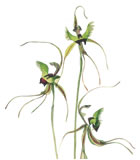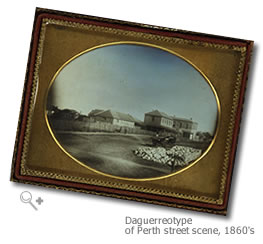Perth Daguerreotype
The daguerreotype was a photographic process invented by Louis Daguerre in France in 1839 which remained popular for some 20 years. The photo was usually made on a thin copper plate coated with light-sensitive silver iodide.
They have a distinctive mirror-like appearance so that they have to be held at an angle for the picture to be seen properly and the figure is shown in mirror image.
Daguerreotypes were normally inserted into a case or frame made of wood bound in leather or velvet. They were generally limited to the wealthier classes as at the time they would have cost almost a week's wage for a labourer in Australia.
Only one copy was made per sitting and no duplicates could be made, which means that each daguerreotype is unique. This example of a Perth street scene taken about 1860 is a particularly fine example of the process.
Unfortunately, it is not known what the buildings in the picture are, but the photograph itself is a wonderful depiction of a part of Perth at the time.




